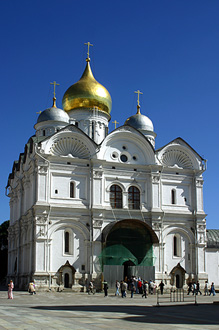|
 The Archangel Michael, a suitably war-like heavenly figure, was chosen as the patron saint of the rulers of Muscovy in the 14th Century. The Cathedral that bears his name was erected between 1505 and 1508 - the culmination of a grandiose building project begun by Ivan the Great to reflect the growing power of the state, and provide a fitting resting place for Russian Royalty.
The Archangel Michael, a suitably war-like heavenly figure, was chosen as the patron saint of the rulers of Muscovy in the 14th Century. The Cathedral that bears his name was erected between 1505 and 1508 - the culmination of a grandiose building project begun by Ivan the Great to reflect the growing power of the state, and provide a fitting resting place for Russian Royalty.
The cathedral was built under the guidance of Italian architect, Alevisio Novi, (Alionzo Lamberti da Montanyano). Novi created a highly original structure by superimposing elements of architectural styles of the Italian Renaissance onto the traditional Russian form of five domes and six pillars. The fasade is decorated with cornices, pilasters with capitals, a false arcade and many other decorative details unusual in Russian architecture, while inside, the enormous pillars dividing the interior into three naves emphasises the Russian origin of the building's structure.
Over the years the Archangel Cathedral has undergone several changes that have altered its initial appearance. Most significantly, two chapels were added to the sides of the cathedral in the late 1500s, and the central dome of the cathedral, which had previously been round, was replaced in the 18th century with a traditional onion-shaped dome.
The interior of the cathedral is dark and atmospheric, decorated with an abundance of rich, earthy colours. The cathedral's frescoes were painted between 1652 and 1666 by nearly one hundred artists under the direction of the famous icon painters Simon Ushakov, Stepan Rezanets and Fyodor Zubov. Starting with the central dome fresco of the holy trinity and extending to the main vault and west wall of the cathedral, the paintings tell the story of the reign of God from the Creation until the Last Judgement. The paintings on the southern and northern walls honour the Archangel Michael, depicting his heroic conduct in the war against Satan. Also on the southern wall is a painting depicting the victory of the Israelite troops, led by Gideon, over the Midian. The prominence of this theme can be attributed to the association of the Midian people with Muscovy's historic oppressors, the Tartars.
The iconostasis of the cathedral dates from 1813, after Napoleon's troops used its predecessor for firewood. Nearly all of the icons were painted much earlier, however, between 1679 and 1681. The oldest icon, depicting the Archangel Michael in full armour, is believed to date from the late 14th Century.
The Cathedral of the Archangel contains the tombs (46 altogether) of all the rulers of Muscovy and Russia from the 14th Century until Peter the Great moved the capital to St Petersburg. The one exception is Boris Gudonov, whose tomb is in the Trinity Monastery of St. Sergei. The Ryurik Dukes are buried along the walls of the Cathedral. The southern wall is where the Grand Dukes and their close relatives were buried. The northern wall is where dukes who had been sentenced to death for misconduct were buried. The vaults of the Romanovs are located in the central part of the Cathedral. There the founders of the Romanov line are at rest: Tsar Michael Fyodorovich, Tsar Alexei Mikhailovich, Tsar Fyodor Alexeyevich and Tsar Ivan Alexeyevich. In 1903, the tombs were covered with glass and copper cases for protection.
One of greatest treasures of the cathedral is the burial vault of Ivan the Terrible. Ivan was the first to take the title of Tsar and therefore merited a special burial chamber, the construction of which he oversaw himself. Nearby are the tombs of Ivan's sons, Ivan Ivanovich (killed by his father) and Fyodor Ivanovich (who succeeded his father.) Restoration work done in the 1950s uncovered 16th Century frescoes including the famous deathbed scene 'Farewell to the Family', depicting the death of a duke surrounded by his family and spirits from the afterlife.
The Cathedral of the Archangel was closed after the October revolution. Since 1955 it has been open to the public as a museum.
|

 The Archangel Michael, a suitably war-like heavenly figure, was chosen as the patron saint of the rulers of Muscovy in the 14th Century. The Cathedral that bears his name was erected between 1505 and 1508 - the culmination of a grandiose building project begun by Ivan the Great to reflect the growing power of the state, and provide a fitting resting place for Russian Royalty.
The Archangel Michael, a suitably war-like heavenly figure, was chosen as the patron saint of the rulers of Muscovy in the 14th Century. The Cathedral that bears his name was erected between 1505 and 1508 - the culmination of a grandiose building project begun by Ivan the Great to reflect the growing power of the state, and provide a fitting resting place for Russian Royalty.